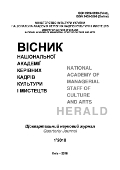PRESENTATION OF HORTICULTURE INSTITUTE PLAN WITH SUSTAINABILITY APPROACH (SOLAR BUILDING)
DOI:
https://doi.org/10.32461/2226-3209.1.2018.178831Анотація
Abstract. Renewable energies will account for two thirds of global power plants by 2040, which is why, in most countries; they are the lowest source of cost for new production. At present, the share of direct and indirect renewable energy in final energy consumption will increase from 39 percent to 45 percent in 2040. The sustainable development scenario is an integrated solution for achieving a wide range of energy-related goals for sustainable economic development: Climate stabilization reduces the cleaner air and universal access to modern energy, and at the same time, the security risk of energy. In this regard, the purpose of this research is to achieve a combined way to access a wide range of
energy goals for sustainable economic development in sustainable architecture with the aim of expressing the study and research of the principles and practical solutions and methods of implementing the design of the flower production center with the aim of the sustainable development scenario for the preservation of the global environment as well as the preservation of the architecture effect in the world ecology system: The climate stability, clean air and global access to modern energy, as well as the reduction of energy security risks, are a comprehensive solution. And it's about the ability of the horticulture institute to combine environmental and atmospheric factors, and combine them with spatial and cosmological qualities, using the technology of the day to use sustainable energies and botanical laboratory which can focus on the laboratory needs of this center and even the region.
This research is based on the analysis and description method. The type of research work is applied.
Key words: space design, targeted agricultural development, sustainability architecture (solar building), heat storage system, greenhouse
Посилання
Solmaz Ahmadi Ghezeldasht, 2-015, a Study of the Effective Factors in Designing the Rose and Botanical Center with a
Sustainable Architecture Approach to the Pakdasht Region. National Conference on Architectural, Construction and
Physical development : Golabchi, Mahmoud, Faraji, Amir, Design Method with Turnkey Approaches, EPC and BOT, and
Bridging Publications and University of Tehran, 2011.
Gilani, Sara Mohammad Kari, Behrooz, "The Study of the Efficiency of Heating of Solar Greenhouses in Residential Cold
Climates Case Study, Ardabil City", Mechanical Engineering Modares, Volume 11, Number 2, 2010.
Mousavi, Layla, 2012. Study of Sustainability Indices in Residential Architecture.
Brooks, K.2011. After LEED: The next generation of green building (Part I). Retrieved June 9, 2012, from Swinerton Builds
Tomorrow.
David Barrett Douglass. Difining ASustainable Aesthetic: A New Paradim for Architecture, Master of building
sciencetesies of university of southern Califonia,2008.
Ghobadian, vahid (2009). ‘‘Sustainable Traditional Building of Iran, A Climatic Anlysis’’ Islamic Azad University, Dubai
universal company publisher, Beirut.
Khoda baksi sh.2002 assessing architecture in hot and dry and pemparate climate. The second seminar on fuel efficien in
building. Munier, Nolbert, (2005), Introduction to sustainability: Roadto a future, the Netherlands: springer.
Vandana Baweja, A pre-history of Green Architecture: of to koenigsberger and tropical Architure, from princely mysore to
post-colonial London, Adissertation submitted in portial fulfillment of the requirements for the degree of doctor of
philosophy (Architecture) in the university of Michigan,2008.
Wang zhe, Zhou li, Shi jing. 2011. On the beauty of green expo architecture and sustainable development—taking “China
Pavilion” as an example. Procedia Engineering 21(163-167).
www. The Eden Project: The World’s Largest Greenhouse
##submission.downloads##
Номер
Розділ
Ліцензія
Автори, які публікуються у цьому журналі, погоджуються з наступними умовами:
1. Автори залишають за собою право на авторство своєї роботи та передають журналу право першої публікації цієї роботи на умовах ліцензії Creative Commons Attribution License, котра дозволяє іншим особам вільно розповсюджувати опубліковану роботу з обов'язковим посиланням на авторів оригінальної роботи та першу публікацію роботи у цьому журналі.
2. Автори мають право укладати самостійні додаткові угоди щодо неексклюзивного розповсюдження роботи у тому вигляді, в якому вона була опублікована цим журналом (наприклад, розміщувати роботу в електронному сховищі установи або публікувати у складі монографії), за умови збереження посилання на першу публікацію роботи у цьому журналі.
3.Політика журналу дозволяє і заохочує розміщення авторами в мережі Інтернет (наприклад, у сховищах установ або на особистих веб-сайтах) рукопису роботи, як до подання цього рукопису до редакції, так і під час його редакційного опрацювання, оскільки це сприяє виникненню продуктивної наукової дискусії та позитивно позначається на оперативності та динаміці цитування опублікованої роботи.

